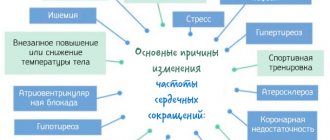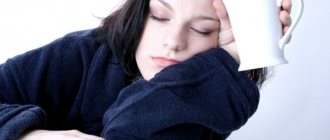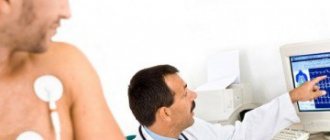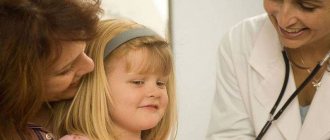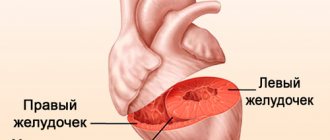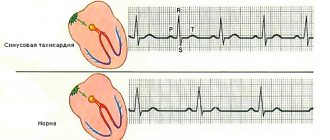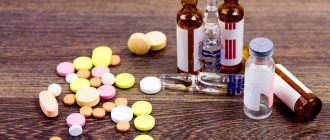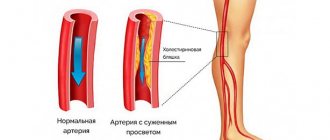5 / 5 ( 3 voices)
The article describes various diseases accompanied by pain in the left side of the chest. The symptoms of these pathologies, methods of diagnosis and treatment are indicated.
Chest pain indicates various disorders in the body
Pain in the heart area - aching, constant - is a sign of various diseases, not only of cardiac origin. The correct cause of pain can be determined by taking into account other symptoms of these diseases, as well as after carrying out diagnostic measures.
Where is the heart actually located?
The heart muscle is considered a vital organ, with a volume approximately equal to a human fist. Its placement in the chest is slightly different from traditional ideas. The right edge is located approximately along the axis of the spine, the left border in men (in women, due to the difference in the shape and size of the breast, this landmark cannot be used) to the right of the left nipple, in height it begins approximately below the level of the collarbone in the area of the spine, in shape, expanding downward, and ends approximately between the 5th-6th rib.
Thus, one must understand that the placement of the heart is not radically left-sided, but simply to the left of the spinal axis.
How to understand whether your heart hurts or not?
After the appearance of pain in the chest, the first thing you should do is figure out and understand what its cause is, whether it is cardiological or non-cardiological.
When the heart or its vessels are susceptible to disease, pain on the left side is called cardiac and the following symptoms are distinguished:
- Location: behind the sternum, to the left border of the clavicle
- The type of pain is very different: aching, pressing, stabbing, dull
- No pain between the ribs or in the spine area
- Pain of cardiac origin is not associated with light physical activity, such as raising and lowering the arms, but occurs after physical activity
- Angina occurs as a result of eating a large amount of food and, for example, active walking after that. It is important to note that there will be no heartburn, belching or bowel irregularities.
- It often radiates to the left hand, the lower jaw on the left, is localized in the left shoulder blade, but there are no sensory disturbances, the left hand does not feel cold, there is no weakness, the skin color is normal.
Painful sensations caused by pathologies of other organs
The cause of pain in the stomach can be pathologies of other organs and systems.
Pancreatitis
Acute pancreatitis is an inflammation of the pancreas tissue. The sensations during an attack of pancreatitis are different. Sometimes the pain is aching, but this is the exception rather than the rule, since the pathology is characterized by a strong syndrome.
The pain extends to the epigastric region (often extending to the back) and can be perceived as stomach pain
Signs of the disease:
- bloating;
- pain in the left hypochondrium when trying to palpate; severe nausea;
- vomiting that does not bring relief;
- increased body temperature;
- tachycardia;
- feces are greasy in consistency and smelly.
Complete disappearance of pain while symptoms of the inflammatory process persist may indicate complete failure of the pancreas.
Duodenitis
Duodenitis - inflammation of the small intestine - is one of the possible causes of aching pain in the stomach. Additional signs of pathology are attacks of nausea and vomiting, severe general weakness, pain when trying to palpate the epigastric area, and an increase in temperature. Acute duodenitis most often goes away on its own.
But with frequent relapses and the absence of adequate therapy, chronic disease cannot be ruled out. The chronic form of duodenitis is characterized by constant but mild pain in the epigastric region. Additionally, there are: a feeling of fullness in the stomach after eating, attacks of nausea, vomiting, and loss of appetite.
Duodenal ulcer
The main symptom of ulcerative damage to the walls of the duodenum is pain. Many people with a similar diagnosis feel them in the stomach area. The disease is characterized by the development of pain approximately 2 hours after eating. Very often my stomach hurts at night. These are the so-called hunger pains.
They intensify under the influence of spicy/sour foods, increased physical activity, with a long interval between two meals, and consumption of alcohol of any strength. The disease is characterized by seasonal exacerbations. The remission period ends in autumn and spring.
Treatment of pathology comes down to strict adherence to diet. Minced meat (meat, fish), mashed potatoes, milk porridge with a liquid consistency, and alkaline mineral waters help eliminate pain. The disease is dangerous due to perforation of the ulcer. This is indicated by the development of severe pain.
Colitis
Colitis is an infectious inflammation of the tissues of the large intestine. Quite often, pain in this disease is projected onto the epigastric region and radiates to the stomach, but not necessarily. Potential signs of pathology include:
- bloating, rumbling in the stomach;
- frequent urge to empty the intestines;
- diarrhea - feces include blood and mucous inclusions.
The acute form lasts several days. Then the symptoms weaken - the pain becomes less intense, but almost never stops.
Nonspecific ulcerative colitis (UC)
With UC, non-infectious damage to the mucous membranes of the large intestine occurs. When the ulcer is located in the lumen of the transverse colon (anatomically it is located under the stomach), pain is felt in the epigastric region.
Signs of UC are:
- chronic diarrhea;
- the presence of blood, mucus and pus in the stool;
- false urge to defecate;
- increased body temperature;
- poor appetite;
- weight loss;
- joint pain;
- general weakness.
Irritable bowel syndrome (IBS)
IBS is a functional gastrointestinal pathology accompanied by chronic abdominal pain in the absence of any disease. Sometimes the main location becomes the stomach area.
Typical clinical picture:
- discomfort/pain in the abdomen;
- rare/too frequent bowel movements;
- uncharacteristic consistency of stool;
- feeling of incomplete emptying of the intestines;
- the presence of mucous inclusions in the stool; heartburn;
- muscle and back pain;
- constant fatigue.
Appendicitis
Inflammation of the appendix is one of the most common pathologies requiring immediate surgical treatment. Initially, pain is felt in the stomach and/or navel. Later they shift to the right iliac region, which is a characteristic symptom of the development of appendicitis.
At the beginning of the development of the disease, the pain is not strong, aching in nature. As the condition worsens, they intensify. There is an increase in the syndrome during walking, coughing, and attempts to change body position. There is an increase in tension in the muscles of the anterior abdominal wall.
Potential signs of appendix inflammation include:
- refusal to eat;
- nausea;
- one-time vomiting;
- slight increase in general body temperature;
- diarrhea may occur;
- increased blood pressure, development of tachycardia.
Coronary heart disease (CHD)
IHD is a heart disease accompanied by disruption of the myocardium as a result of damage to the coronary arteries. Pain in this pathology occurs during physical activity or in stressful situations. The main area of localization is behind the sternum.
But in some cases it spreads to the epigastric region, simulating stomach pain. Typical complaints in the presence of IHD are shortness of breath, irregular heart rhythm, swelling of the legs that does not go away after taking diuretics and a long night's rest, and general weakness.
Non-cardiological nature of the pain that occurs
Non-cardiac means that the pain is not caused by the heart. If the intensity of pain on the left side varies with bending, turning the body, deep breathing, swinging and rotating the arms, and nitroglycerin does not have a neutralizing effect, then most likely the source will be intercostal neuralgia or radiculitis of the chest.
Neurosis is possible, the nature of the pain in it is aching or stabbing, it is concentrated locally and manifests itself briefly or periodically.
It has been proven that even ordinary stress and depression can cause physical pain in the left chest, so the classic scene when a woman clutches her heart after hearing something that shocked her is not a work of fiction.
The stabbing and squeezing nature of the pain is often caused by problems with the intestines, bloating, which disrupts the normal functioning of the heart muscle. If, when eating a certain type of food, you experience pain in the left breast, then perhaps the problem is the malfunction of the pancreas or the stomach itself. In addition to those indicated, a likely source may be a weak thoracic region, spinal curvature or osteochondrosis.
With neuralgia of the intercostal nerves (intercostal neuralgia), pain, which can be both chronic and acute, appears due to compression of the intercostal nerves. This type of pain is usually accompanied by burning, tingling or numbness in the rib area, including the left side. A characteristic feature is the lack of improvement effect if you take nitroglycerin. Intercostal neuralgia often appears with age; it can be caused by diseases of the spinal column, diabetes mellitus, and pathologies of the stomach and intestines.
There is no treatment for intercostal neuralgia as such. Usually the doctor’s task is to relieve pain on the left side and improve the condition of the intercostal nerves, preventing recurrence of the disease. To do this, they prescribe medications that relieve spasms, conduct a course of physiotherapy, and sometimes acupuncture.
With osteochondrosis of the thoracic region, the cartilage tissue of the joints wears out, which leads to pain during movement or stress.
Causes of cardiogenic pain
If the heart aches due to its pathology, then it is important to determine the specific group to which it belongs:
- Inflammatory diseases of the heart: endocarditis, myocarditis, pericarditis. All of them are united by inflammation of the myocardial walls. The nature of the pain is dull or stabbing, gradually increasing. Shortness of breath, weakness, intoxication, and palpitations begin.
- Myocardial dystrophy, which occurs as a result of a metabolic disorder in the tissues of the heart muscle, reducing its contractility. There are many different reasons for this. The disease progresses, a dull aching pain in the heart region develops into intense pain, and chronic heart failure suddenly manifests itself.
- All kinds of defects do not provoke painful syndromes, but accompanying disorders are the reason that the heart aches.
- IHD – cardiac ischemia develops when there is a mismatch between the need for oxygen and the amount supplied by the bloodstream. This occurs due to narrowing of the lumen of the coronary vessels as a result of atherosclerosis.
Its consequence may be:
1. Angina pectoris.
2. Myocardial infarction is a situation when the lack of oxygen becomes critical and tissue necrosis occurs in a specific area.
Its associated symptoms:
- nausea;
- hypotension;
- sweating;
- pallor;
- dyspnea;
- heart rhythm disturbances;
- fear of death.
Finding the Causes of Pain
After pain appears on the left side of the chest, the first thing you should do is consult a cardiologist to find out whether the pain syndrome is cardiological in nature.
The most accessible method for quickly diagnosing the functioning of the heart muscle and identifying pathologies in it is an ECG or electrocardiogram. The essence of the study is to attach sensors to the body, which, capturing the rhythm of the blood beat, produce a graph.
Using this chart, the cardiologist determines the presence of abnormalities in certain parts of the heart. A traditional ECG consists of obtaining a cardiogram in a quiet mode for just a few seconds. Often such a study is not enough to identify pathologies, then an ECG is performed “under load”, or Holter monitoring, when sensors and a receiver, powered by a battery, are attached to the patient’s body and readings are taken throughout the day. Due to this, the doctor sees a complete picture of the behavior of the heart muscle during all periods of wakefulness and sleep. Phonocardia is used to check for the presence of a heart murmur.
The general condition of the organ, as well as the functioning of the valves and the flow of blood in various parts of the heart, is checked using a procedure called echocardiography.
To assess the condition of the coronary arteries, a coronography procedure is performed, and deficiencies in the blood supply are checked using myocardial scintigraphy.
To verify the “non-cardiac” origin of pain on the left side, chest examinations are used using X-rays, computed tomography and MRI of the spinal region; for this you need to contact a neurologist or orthopedist; for more in-depth examinations, you need to visit a gastroenterologist.
When examining a patient, a cardiologist pays attention to how the patient talks about the symptoms.
The following relationship is used for assessment: if the patient speaks very vividly, in detail and openly about his painful sensations, without skimping on details, then, most likely, this indicates that the heart is not the source of pain.
An additional factor in favor of this conclusion is the detail that the pain is accompanied by a rapid heartbeat. And vice versa, a meager and dry narrative about the presence of pain with precise details, rather talk about “heart” reasons.
Neuralgia: symptoms and treatment on the left side in the heart area, causes of pathology
Signs of neuralgia to the left of the sternum are often confused with diseases of the heart and vascular system.
Despite the fact that pathologies have their differences, many people worry about their health, which leads to various psycho-emotional disorders.
To prevent the progression of the condition, various treatment methods are prescribed, aimed at eliminating the etiological factor and the clinical picture of the pathogenic processes.
Symptoms of neuralgia on the left side of the heart
Neuralgia in the heart area develops as a result of pinching or irritation of the fibers of the intercostal nerves. Useful information The main symptom of the pathology is pain. It can have a sharp, dull, aching and burning character. The pain is paroxysmal and localized to the left of the sternum, as a result of which most people think that it is associated with cardiac activity.
Discomfort in the cardiac zone increases with physical activity, breathing, coughing, which is accompanied by a feeling of squeezing of the ribs. The patient may also experience local hyperemia or blanching of the skin, as well as involuntary muscle twitching. Often there may be tingling in the chest and numbness of the skin between the ribs.
Causes of neuralgia on the left
Chest pain on the left, which is caused by neurological pathologies, develops due to pinching or irritation of the intercostal nerve fibers. This can be due to a number of factors, the most common of which are:
- chest injuries;
- Bekhterev's disease;
- herniated intervertebral discs;
- prolonged tension of the intercostal muscles;
- curvature of the spinal column.
The development of neuralgia in the heart area is often associated with psycho-emotional stress, hypothermia, the action of infectious agents or intoxication of the body. Rarely, pain syndrome to the left of the chest is observed with herpetic lesions, pleurisy, or taking certain medications.
How to distinguish heart pain from neuralgia?
Most people often confuse heart pain with attacks of intercostal neuralgia. To prevent this, it is necessary to have an idea of the signs that make these pathologies different from each other. These include:
- During an attack of neuralgia in the heart area, the pain intensifies with physical activity, deep breaths, coughing, palpation of the ribs and the spaces between them. In the case of cardiogenic pain, these factors do not affect them.
- With intercostal neuralgia, discomfort can spread to the upper chest and be felt under the collarbones, in the lower back and shoulder blades. Unpleasant sensations can last from several hours to several days. With cardiac neuralgia, the pain is localized behind the sternum, and can sometimes radiate to the left arm. Their duration does not exceed 10-15 minutes. Pain syndrome during ischemia is relieved by taking several Nitroglycerin tablets.
- Attacks of intercostal neuralgia are not accompanied by changes in pulse and blood pressure, which are observed with cardiac disorders.
Features of symptoms in pregnant women
Neuralgia in the heart area during pregnancy is associated with the characteristics of the woman’s body during this period. The figure is subject to significant changes, which consists of a shift in the center of gravity and an increase in body weight. In combination with hormonal imbalance, these factors can lead to chest pain on the left.
The unpleasant sensations are nagging in nature. They intensify as pregnancy progresses. If pain occurs in the intercostal spaces, you should seek help from a doctor so that the pathology does not interfere with the course of pregnancy.
Diagnostics
If the patient has unpleasant sensations to the left of the sternum, the doctor collects complaints. During this, he determines the nature and location of pain, as well as the presence of accompanying symptoms.
After this, the doctor begins to collect an anamnesis of the disease and life. This procedure makes it possible to obtain the necessary information about the onset of pathological processes, their possible cause, as well as the characteristics of the course of clinical symptoms.
To confirm the diagnosis, instrumental and laboratory research methods are used. For the differential diagnosis of neuralgia of the heart with intercostal attacks, the following is used:
- general and biochemical blood tests;
- X-ray diagnostics;
- ultrasonography;
- ECG;
- EchoCG;
- computer and magnetic resonance imaging.
Using an electrocardiogram, the doctor evaluates the functioning of the heart. This method, in combination with x-ray diagnostics, makes it possible to identify pathological foci that can cause acute, severe pain to the left of the sternum.
A timely and adequate examination eliminates the possibility of establishing an incorrect result. It also significantly reduces the likelihood of disease progression and the development of severe complications.
Treatment
The tactics of treating neuralgia on the left side in the heart area consists of the integrated use of various techniques, among which the most effective are:
- drug treatment;
- physiotherapy;
- therapeutic massage and exercise therapy;
- alternative medicine.
Drug treatment
The main method of eliminating discomfort to the left of the sternum is taking medications. The most effective groups of drugs for neuralgia in the heart area are:
- Painkillers. Acute stabbing pain can be effectively relieved with Analgin, Paracetamol, Tramadol, Baralgin, Piralgin, Pentalgin, Sedalgin.
- Non-steroidal anti-inflammatory drugs. To eliminate foci of inflammation, Ibuprofen, Ketoprofen, Nimesulide, Celecoxib, Diclofenac are used.
- Selective and non-selective muscle relaxants. Most often, doctors prescribe Baclofen, Mydocalm, Sirdalud.
- Cardiac glycosides. Neuralgia of the heart is eliminated by Digoxin, Strofactin, Korglykon.
- Chondroprotectors. For the regeneration of cartilage tissue, the drugs Artra, Alflutop, Rumalon, Structum, Teraflex, and Chondroitin are used.
In case of acute heart pain, as first aid it is worth taking a supine position and placing your legs below body level. After this, it is recommended to remove thick clothing and provide the patient with fresh air. This is done so that a person can breathe normally and receive the necessary amount of oxygen for the functioning of organs.
Next, you need to take a Nitroglycerin tablet under the tongue. If there is no effect, you need to take another one. It is not recommended to take more than two tablets of the drug, as this can lead to a sharp decrease in blood pressure, which will aggravate the situation.
Physiotherapy
Along with drug therapy, the doctor may prescribe physiotherapeutic procedures. For cardiac neuralgia the following are used:
- electrophoresis;
- water and mud procedures;
- laser treatment;
- magnetic therapy;
- acupuncture.
Therapeutic exercises and massage
In the conservative treatment of some diseases, therapeutic exercises and massage are prescribed. With their help, they improve blood circulation in the affected area and relieve spasms of muscle fibers. An experienced massage therapist should select a set of exercise therapy exercises. This will avoid the development of complications and make the treatment safe for the patient’s health.
Treatment with folk remedies
Among alternative medicine recipes, compresses are the most effective. For their preparation use:
- potato;
- onion;
- black radish juice.
Onions and potatoes are grated in equal quantities, and then poured with black radish juice. The mixture is wrapped in a multilayer piece of gauze, applied to the affected area and kept there until completely dry.
Prevention
To prevent the development of neuralgia in the heart area, you need to give up bad habits, lead an active lifestyle, eat a balanced diet and exercise. Compliance with these rules will significantly reduce the likelihood of developing pathological changes in the human body.
Neuralgia in the heart area manifests itself as a result of damage to many organs and systems. If they are present, it is recommended to go to a clinic or hospital for consultation with a specialized doctor. He will help diagnose the underlying disease and also prescribe effective treatment tactics, which will preserve the patient’s health.
2897 ratings
Source: https://nervy-expert.ru/neurology/nevralgiya/nevralgiya-simptomy-i-lechenie-na-levoj-storone-v-oblasti-serdca/
What to do if you have chest pain on the left?
Chest pain on the left first of all leads to the idea of heart problems, which may be the real reason. Therefore, when such a pain syndrome appears, you need to stop any physical activity, take a lying position, reducing the load on the heart and muscles, and provide an influx of fresh air into the room.
Regardless of the type of pain, if you are not completely sure of its “non-cardiac” origin, you need to put 1-2 tablets of nitroglycerin under the tongue. If your condition improves, contact your physician for an initial examination. A headache may occur after taking nitroglycerin; this is common as it lowers blood pressure.
If there is no effect from taking nitroglycerin, but difficulty breathing, weakness, pallor, and semi-fainting remain, then you should immediately call an ambulance, mentioning the pain in the left side of the chest and that nitroglycerin did not relieve the symptoms.
If the heart pain goes away immediately after being brought to a state of rest, then it is still important to contact a general practitioner, asking to schedule an ECG and an examination by a neurologist.
Nature of the pain syndrome
What kind of pain can there be in the heart area? Patients describe such sensations in the chest area in different ways. They can be aching, stabbing, pressing, burning, piercing, squeezing and pulling. It also happens that chest discomfort does not last very long. Although sometimes it may not let go for several hours or even days.
Pain on the left side, in the area of the heart, can occur at rest, during severe anxiety, and also after heavy physical work. It should also be noted that sometimes such sensations appear only with sudden movements, turns, bends and deep breathing. In addition, the pain may be accompanied by a feeling of suffocation, shortness of breath, cough, numbness in the hands, rapid heartbeat, increased body temperature, and may also radiate to the arms, shoulder blade, jaw or neck.
Prevention of pain in the left side of the chest
As you learned from the article, the cause of pain on the left side of the chest is not always the heart muscle; in most cases we are talking about neuralgia, osteochondrosis, diseases of the stomach and intestines. For prevention in this case, it is necessary to reduce the effect of factors leading to complications. You should not overload yourself with excessive loads, eat a balanced healthy diet rich in vitamins, pay attention to sports, but without heavy loads. Exactly the same recommendations apply to prolong the proper functioning of the heart.
Basic information about pain syndrome
According to statistics, pain in the area of the heart when inhaling or exhaling is the most common reason for patients visiting the ambulance service. However, experts say that this symptom is not always a sign of impaired functioning of the main muscle of the human body.
So why does pain appear in the heart area? Diseases of the gastrointestinal tract, nervous system, bones, some internal organs and joints may well cause the development of such unpleasant sensations in the chest.
It is quite difficult to determine on your own why pain occurs in the heart area. Diagnosis of such discomfort is complicated by the fact that in different situations the heart muscle can hurt in different ways. Only an experienced specialist can identify the true cause of such sensations.

